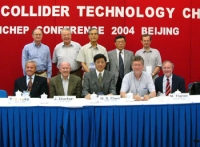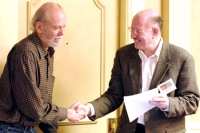Director's Corner
15 March 2007
 Barry Barish |
Salute to Jonathan!
Earlier this week, Jonathan Dorfan announced in SLAC Today that he is stepping down this fall as SLAC Director after eight very successful years. Jonathan has not only been serving as SLAC's leader during this period, but he has also been a driving force in the world high energy physics community over the past decade. Jonathan's contributions to the field are many, but they are epitomised by the leadership he provided to the International Committee for Future Accelerators (ICFA), which he chaired from 2003-2005. As the world of high energy physics had become more and more international, Jonathan strongly supported the many initiatives that have placed high energy physics at the very front of international collaboration in physics, and in fact in science.
 Jonathan Dorfan (second from left, front row) presiding over the ICFA press conference announcing the selection of superconducting RF technology for the ILC |
 Barry Barish officially accepting the position of Director of the GDE from Jonathan Dorfan at the SLAC LCWS meeting in March 2005 |
I fondly recall sharing the stage with Jonathan at the last International Union of Physics and Applied Physics (IUPAP) General Assembly in Capetown, South Africa (Jonathan's hometown!) in October 2005. He gave an impressive presentation on the subject of international collaboration in high energy physics, and I followed with a description of our global collaboration toward the ILC. In today's column, I recall in personal terms both Jonathan's role in drawing me into the ILC effort and the crucial counsel and support he has provided for us as we have steadily moved forward toward realising our dreams.
Jonathan and I have a long history and friendship that dates back to being collaborators on the Mark II detector at the SLAC Linear Collider (SLC). (In fact, at one point, I tried unsuccessfully to recruit Jonathan to Caltech.) In subsequent years, our interactions were more distant as I became involved in physics away from accelerators and accelerator laboratories, first in MACRO, an underground particle astrophysics experiment at the Gran Sasso in Italy, and then as Director of LIGO, a search for gravitational waves. This all changed when I received a phone call from Jonathan and Maury Tigner in the fall of 2004, asking me to serve on a panel (ITRP) to recommend to ICFA on the choice between “warm” or “cold” technology for the ILC. I was reluctant to serve on this panel, both because of my busy schedule and also because I strongly believed that technical choices should be made by those closest to the technology. Jonathan and Maury, however, managed to convince me to serve and then to actually chair this panel.
I recall Jonathan making a crucial promise to me during those discussions: whatever technology we chose, the laboratory directors would stand behind our choice! Now let's fast forward to the moment of our announcement of the technology decision, which was immediately before the ICFA meeting in Beijing in August 2004. I vividly recall calling each laboratory director hours before that meeting to inform them of our recommendation. Keep in mind that SLAC had dedicated years to developing room temperature copper technology. When I called Jonathan and told him that we were recommending superconducting RF, he was basically rendered speechless for the only time I can recall in our long association. I awkwardly filled the void with random words until Jonathan said to me, “We (the lab directors) will stand behind your recommendation.” Hours later, Jonathan chaired the ICFA meeting and press conference and announced the decision in a most statesman-like and supportive manner. This action alone set the tone for all those involved to quickly lick their wounds and join together in the new effort to create a global design for the ILC.
Maybe less dramatic, but at least as important to me, Jonathan was instrumental in my present job as Director of the GDE. I recall my “interview,” where I was supposedly just being “consulted” on how I would approach this job. I said that I would not establish a central location at the beginning, in order to ensure that we could involve the key experts. I also said that we should first establish a configuration, put in place a change control system so that the configuration could evolve, and then do a reference design, followed by an engineering design. Jonathan's strong agreement with this step-by-step approach was instrumental in my accepting this position in March 2005. Since that time, Jonathan has been one of the strongest supporters of our efforts. He has not only been the first to acknowledge our accomplishments and support our efforts, but he also has never been shy to tell me personally where we need to do better.
I have truly valued and relied on Jonathan over the past two years. I now alert him that I fully intend to press him very hard to become directly engaged in the GDE, as we move forward toward bringing the project to reality. We need him!
-- Barry Barish